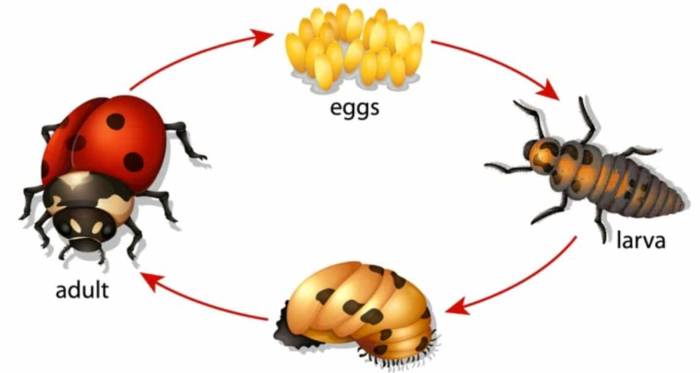Other names for ladybugs include lady beetles, ladybug beetles, and ladybird beetles. No matter what you call them, these beetles are members of the family Coccinellidae. Ladybugs undergo a four-stage life cycle known as complete metamorphosis.

Table of Contents
Embryonic Stage (Eggs)
A ladybug’s life cycle begins with an egg. When a female ladybug mates, she lays five to thirty eggs.1 She usually deposits the eggs on plants that have suitable prey for her offspring to eat; aphids are a favorite. During the three-month period starting in spring or early summer, a single female ladybug can produce more than 1,000 eggs.
The cluster may contain both fertile and infertile eggs laid by ladybugs. In the absence of aphids, newly hatched larvae feed on infertile eggs.
Larval Stage (Larvae)
The larvae of ladybugs emerge from their eggs within two to ten days.3 Environmental factors like temperature can shorten or lengthen this period of time. A ladybug larva has an elongated body and bumpy exoskeleton, similar to an alligator larva. Many ladybug species have black larvae with brightly colored spots or bands.
Ladybug larvae feed voraciously during their larval stage. A single larva can consume 350 to 400 aphids in the two weeks it takes to grow fully.4 Larvae also feed on scale insects, adelgids, mites, and insect eggs. It is not uncommon for ladybug larvae to eat ladybug eggs as well when they are feeding.
A newly hatched larva is in its first instar, a developmental stage between molts. Molting occurs when it grows too big for its cuticle, or soft shell. The larva is in its second instar after molting. The larvae of ladybugs molt through four instars, or larval stages, before they pupate. In order to pupate, or metamorphose, the larva attaches itself to a leaf or other surface.
Pupal Stage (Pupae)
Ladybug pupae are usually yellow or orange with black markings. The pupa remains attached to a leaf throughout this stage. The ladybug’s body undergoes a remarkable transformation, which is controlled by cells called histoblasts. By controlling a biochemical process, they transform the larval body into the adult ladybug.
Imaginal Stage (Adult Beetles)
Newly emerged adults, or imagos, have soft exoskeletons, which makes them vulnerable to predators until their cuticles are hardened. Initially, ladybugs appear pale and yellow when they emerge from the ground, but they soon develop the deep, bright colors that are associated with them.
It is the larvae of ladybugs that feed on soft-bodied insects, just as their adults do. The adults overwinter in groups of up to a dozen individuals, usually hibernating in groups. When they become active again in the spring, they mate as soon as they become active again.
Finding Eggs and Larvae
Garden plants that are prone to aphid infestations are ideal habitats for ladybugs to live. If you would like to learn more about the ladybug life cycle, you can visit this plant on a daily basis. You may find a cluster of bright yellow eggs on the undersides of the leaves if you examine them closely and lift them up to inspect the underside.
In a few days you will find tiny ladybug larvae hatching into immature ladybugs, and you will find these weird-looking immature ladybugs on the prowl for aphids. In the future, you will see dome-shaped pupae that are shiny and orange in colour. There is a good chance that adult ladybugs will also hang around if there are a lot of aphids around.
